The Swing 2 - The Other Swings
In last month's swing article, I discussed the basic principles behind the swing and detailed the mechanics of three different swings. This article will examine several other swings. But, first, let's review the four fundamental factors involved in generating and maximizing swing:
- Maximizing momentum in the downward phase of the swing
- Maintaining momentum throughout the swing
- Maximizing the application of force against gravity on the upward phase of the swing
- Minimizing loss of speed in the upward phase of the swing
The basket swing: https://www.youtube.com/watch?v=QOsG3BeQeX0
A basket swing is any swing in which your shoulders and body are piked so that your center of gravity lies between your shoulders and the anchor point of the swing. This swing is difficult to develop. It has a very short swing cycle, and a small deficiency in the mechanics can have a dramatic dampening effect on the swing. This swing can be performed either straddled or piked, but will be discussed primarily as piked in this article.
Start the swing by hanging in an inverted pike under either a single bar or parallel bars. (You will be hanging with straight arms, chest facing the ceiling, completely folded at the hips, with your knees in front of your face.) In the case of the parallel bars, your hands should be on the inside of the bars, turned out (pronated), thumbs pointing forward. This grip will allow the swing to travel above the bars. Initiate the swing from your shoulders. Push the bar(s) forward and backward as hard as you can without bending your arms or allowing your legs to drop either forward or backward. Initially maintain as tight a pike as you possibly can and try to keep your legs parallel with the ground. Try to feel the period of the swing and add pressure to increase the swing as you are able.
Once you have a feel for the timing of the swing, you can begin to incorporate a pump. To maximize momentum, you will want to be as compressed as possible during the downward phase of the swing. This entails pushing away from the bar(s) and bringing your legs as close to your body as possible. As the swing passes vertical, open your hips to shorten the radius of swing to gain height, but be prepared to compress again quickly once the swing peaks to build into the next swing. This compress/open cycle must occur on both the forward and rearward swing to be effective and requires significant practice to learn.
In addition, you can also drive the swing by shifting your center of gravity off the centripetal line of force. Shifting the center of gravity behind the centripetal line of force will drive the swing forward. In the rearward swing (in which your head is leading), push your arms closer to your feet. Start with just a small shift as it will have a significant impact on the mechanics of the swing. In the forward swing, push your arms closer to your hips. If these pushes are well timed, and the other mechanics of the swing are maintained, this pumping action will dramatically increase the force of the swing.
Optimally this swing can be taken up to a support in both the forward or rearward swings, though in the forward swing on parallel bars the bars must be released as the swing transitions above the bar.
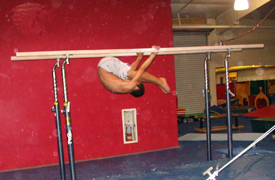
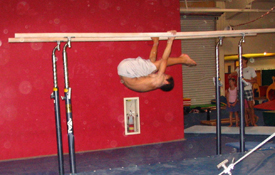
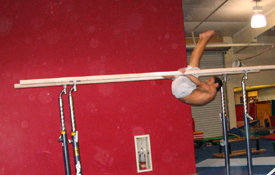
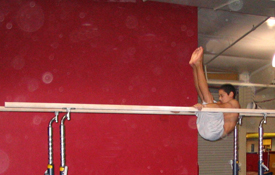
Upper arm swing: https://www.youtube.com/watch?v=MsHhhwjWq6I
This swing could also be called "the dreaded upper arm swing."At first this swing can be quite uncomfortable, but the discomfort diminishes with time. On parallel bars, rest the insides of your upper arms on the bars. Grab the bars so that there is about a 90 degree bend in your elbows. Your hands should be a good distance away from your shoulders. From your shoulders, press the bars downward. If you relax your shoulders you will drop down between the bars. This makes the swing significantly more painful and results in loss of momentum through the bottom of the swing.
An upper arm swing can have a tap (or small upward kick of the feet) like that in the tap swing on a bar (see last month's "Swing" article). The timing is the same, but the tap is less pronounced. For the rearward swing, extend as much as possible in the front to a slight arch, hollow through the bottom then drive your heels toward the ceiling. For the forward swing, extend to a slight hollow arch through the bottom then kick your toes toward the ceiling.
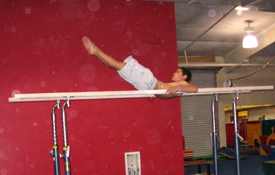
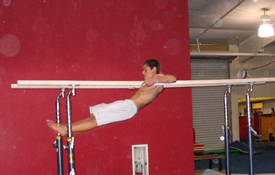
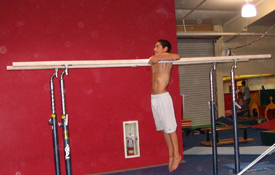
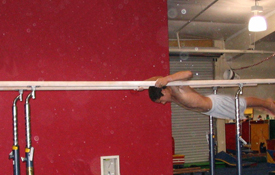
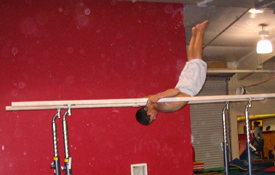
Glide swing: https://www.youtube.com/watch?v=zVhKHMXJcXQ
A glide swing is used to set up for a kip to support. By performing a glide swing you can set up a near vertical line of travel in the rearward swing, which will eventually give you an easy way to get on top of the bar(s). The main purpose of a glide swing is for the forward swing to stretch forward rather than upward, as is usually the goal. This creates a momentary pause in the front with pressure back on the bar that allows the mechanics of a kip to support to function properly.
Start with a bar that is at about chin height. Place both hands on the bar and stick your butt out so your shoulders are completely open. Keep your arms by your ears. Jump back and lift your toes slightly. On the jump do not close your shoulder angle at all. Instead push away from the bar to help generate swing. As you swing through to the front, allow your feet to glide just off of the floor (hence the name). Extend in the front as much as possible by pressing the bar back. This is similar to the push forward at the bottom of a kipping pull up, but you do not arch in the front-just press the bar back to open your shoulders as much as possible. As the swing reverses into a rearward swing, pike at your hips and bring your toes to the bar. Be sure to bring your toes to the bar by piking at your hips, not by closing your shoulder angle. Keep pressure back on the bar as long as possible.
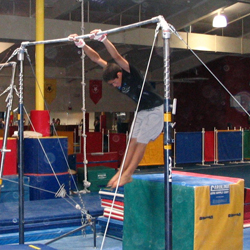
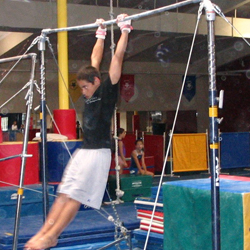
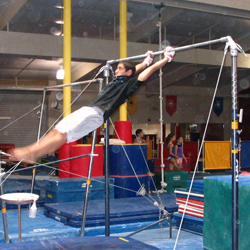
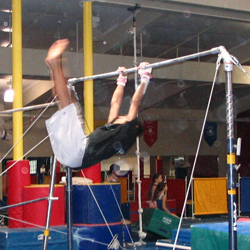
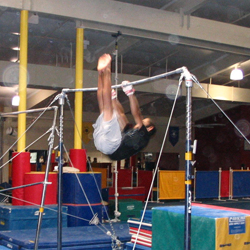
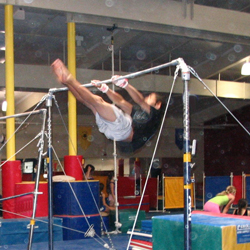
Swinging from a rope or other equipment
The principles discussed through the various gymnastics swings can be applied to swings in which your body is not the primary anchor line, such as swinging on a rope. Swinging from ropes and other objects can be done just for fun and for body awareness and strength development, but it is also a skill that could prove to be invaluable. Depending on your occupation and lifestyle, or just random events, you could find yourself hanging at the end of a rope where your best option is to swing to a solid object, rather than climbing to the top of the rope. Being able to generate swing quickly and efficiently will save time and energy.
For this discussion I will assume you are holding onto the rope with your feet anchored either by standing on a knot in the rope or using one of the various rope climbing techniques to create a good foothold. On the downward phase of the swing you will want to maximize the generation of momentum. To move your center of gravity away from the anchor point of the swing, squat down on the rope, then as the swing passes through vertical, stand up to move your center of gravity toward the anchor point.
In addition, the swing can be pumped by shifting your weight off of the centripetal line. Lean away from the rope opposite the direction of swing, then as the swing peaks, shift your weight to the other side of the rope.
The typical pump that is used on playground swings is not as effective as it could be. The primary factor in the pump that drives the swing is the shifting of weight off of the centripetal line. The way most people swing, with their legs and torso in opposition, does not shift weight as much as it could. In the forward swing you should lean back, as is normal, but also bend your legs back under the swing rather than sticking them straight in front of you. This position causes a greater shifting of weight, which will generate more swing. To do the same in the rearward swing, lean forward, but also keep your legs straight so you are in a pike rather than having your feet tucked under the swing.
These concepts can be applied to any swing. Whenever you encounter swinging, look at the mechanics and see if any of the four maximization factors can be improved. Slight modifications in technique can often have dramatic impact on the efficiency of the swing.
By Roger Harrell.
Related Events:
High Bar
Uneven Bars
Parallel Bars
Related Skills:
Kip
Kip
Basket swing
Kip (single rail)
Upper Arm Swing to Horizontal
